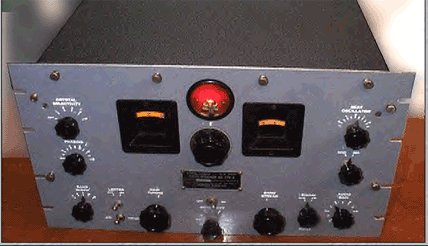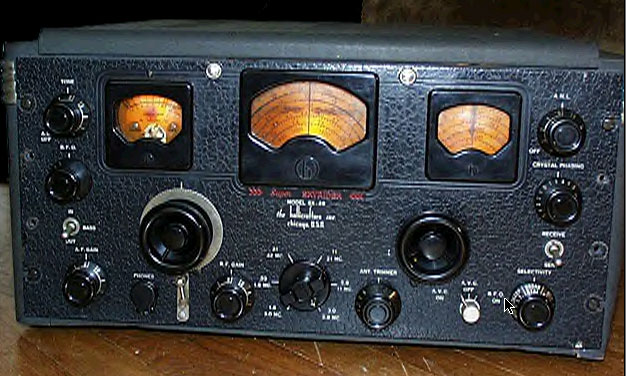
|
Okay. So I'm a sucker for anything with tubes. Sorta like the guys in the picture above,crowded around an AM rig, swiggin' beer on a Sunday afternoon. Here's how it happened and why. A decade or so ago, big, tube-type boatanchors were merrily sledgehammered and thrown into scrap piles for entertainment at ham fests. Everyone laughed as the heavy metal beheamoths were smashed and their parts scattered. Solid state was the thing. Boatanchors were uncool. But boatanchor value began skyrocketing recently. If you look on eBay, you see prices that make your head spin. $300 for a Hammarlund that could once be had for $50 and change. $200 for a Japanese Argonne crystal microphone (which when new, sold for $7.98 in the 60's) that could be picked up for $2 at a swap meet fifteen years ago. You get the idea. I always had planned to get some "boats" on the air...someday. But now it was a good bet that if I waited too long, I wouldn't be able to afford it. I hatched a desperate plan. Grab an old transmitter and pack it away for safekeeping. Within a day or so I saw an ad for a Johnson Ranger. The price looked right. I grabbed it. All 45 pounds of it. |

|
I figured I'd get it into working order before I packed it away. It took up room on the kitchen table for two weeks. Resoldering a high voltage lead and a couple of new pilot lamps later, I had it working into a dummy load. Of course it'd need a Dow-Key relay for T/R. I promptly hunted one down. And some other, er, parts. I mean, what good was a transmitter and a relay without a proper receiver...one that went really wide and would sound really mellow with those AM signals? |

|
Next thing I knew I had a National NC-300. The front panel looks like a Cadillac grille, and weighs nearly as much. Great sound too. So now I had it all. Or most of it. Er, might as well try the Ranger and the NC300 out on the air before packing them away, right? Sounded logical. Except that they never got packed away. I built a special freestanding wooden shelf to squeeze them inbetween two bookcases in my already overcrowded shack. To use on the air. ---> Check out more pics of my shack here. Pretty soon I found myself yakking regularly with the local AM gang. Listen to what Reseda, CA ham Gary, W6GY sounds like on my receiver. Listen to a moment of the action on the West Coast 75 meter AM net. Sigh. The moral? There really isn't any. Boatanchors'll getcha. Eventually.
Why Boatanchors ? by John Brewer WB5OAU Some may question the desire for 80 pound receivers and 100 pound transmitters, both with filaments sitting there getting hot and wasting power in this day of microprocessor based, mega-memoried miniaturized transceivers! Although modern radios are extremely good at what they are designed to do, they are about as interesting to operate as a toaster oven. They have no soul. Additionally, many find a zen-like feeling in taking an old, misused ratty old radio and carefully restoring it back to health. Like cars of the era, boatanchor radios were made to be worked on, modified, and tinkered with. Many think of it as Real Radio in this era where fixing a transceiver is accomplished by boxing it up to send to the manufacturer for a custom VLSI chip replacement. Indeed, a warm soldering iron is almost a requirement for operating a vintage station. Others claim that boatanchors SOUND better than their silicon descendents, and this is generally true. The audio from a Hammarlund or National receiver, or a Johnson transmitter can sound much better than the 300mW audio coming out of the 2" speaker in the typical transceiver.

A 6146 glows in the PA section of a Johnson Viking Ranger I Watching the flicker of 807 modulators in a Viking I as you speak into a D104 mic, is certainly more stirring on a winter night than considering hole and electron flow. If truth be known, much, if not all of the above, although true, are merely justification for the insatiable hunt for more and more of these old boxes, simply because they are just too NEAT to have and operate! High Fidelity AM Reception de W1GFH This is the military version of the HAMMARLUND SUPER PRO, the BC779. Mine is serial number 171, built in the early 1940's. This is an awesome receiver on AM. It has a variable IF that opens up to 16 KHz and makes SW signals sound like hi fi. Wow!  At 66 lbs.this baby is a HEAVYWEIGHT. But the amber glow of the dials and the round S-meter is really nostalgic - whether you're working 75 meter AM or listening to the BBC on it. Not long after I got the Super Pro I came across a massive 1950's church organ cabinet with a 12" speaker in it. It makes a perfect table for the rig and really shows off the 15 watts of audio this baby pumps out. Most communications receivers have a fixed IF bandwith of approximately 4-6 KHz to provide maximum intelligibility of speech, especially under difficult conditions. This limits the high-frequency audio response to 2-3 KHz. Because one of the target markets for the Super-Pro was broadcast monitoring and network rebroadcast, it was provided with this variable bandwith feature. When conditions are good, the passband can be opened up to enjoy the music. Conversely, the IF can be tightened up to a very restriced 3 KHz to "dig out" voice signals when the going gets tough. This hi-fi capability is reinforced by a very clean sounding 14-watt audio amplifier using push-pull triode-connected tubes. It will, indeed, provide room-filling volume. A Super-Pro, connected to a good speaker system, will outperform virtually any AM broadcast receiver ever built.
More High Fidelity AM A Hallicrafters SX-28. Restoration completed!  This particular radio is considered to be the height of Hallicrafters achievements in the mid 1940's. Many BA afficionados feel it to be the "Holy Grail" of SW receivers. This rig also has a GREAT sound on AM. It is extremely close to the BC-779 in terms of fidelity, but has that undefinable "something extra" that makes it very nice to listen to. Plus it's pre-Pearl Harbor styling (check out those steering wheel knobs!) is really nostalgic. Put "Victory At Sea" on the turntable and crank up the push-pull 6V6 audio! A swap for an RME 84 Receiver I swapped the NC-300 for this RME 84. It's a 1958 model with an external S-meter. Great sound from a single 6V6 audio stage.
A CB to 10 Meter Conversion A Heathkit CB-1
Local ham Dave, WD4PLI/6, gave me this Heathkit CB-1 converted for use on 10 meters. Single channel crystal control with regen receiver, this little "lunchbox" puts out about 2 watts of RF and uses a 6AQ5 modulating a 6AU8 final. True plate modulation is achieved and nice warm BA audio produced by the vintage Argonne AR57 crystal mike. |
